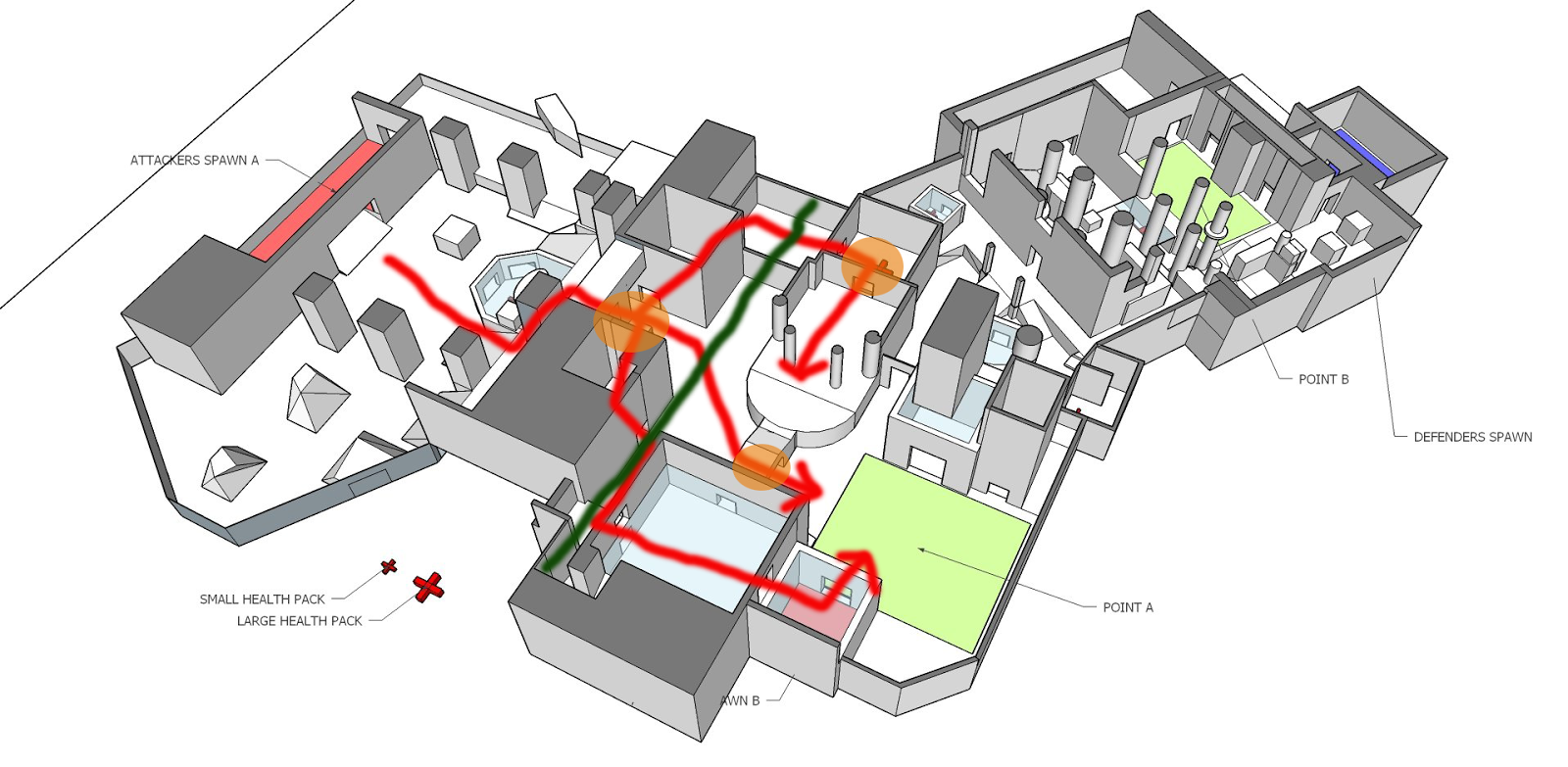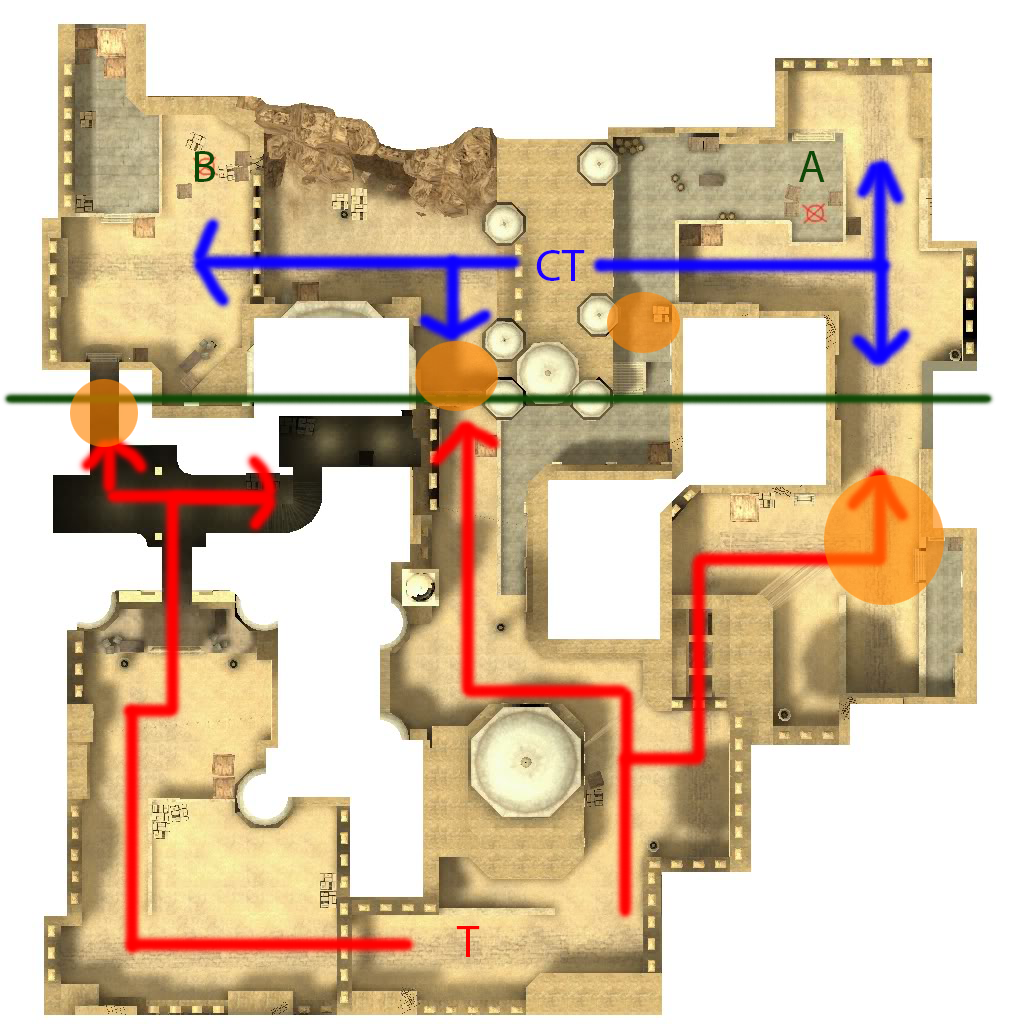Analysis of level schemes to improve multiplayer shooters
- Transfer

The world of competitive games is on the rise, so more and more first-person shooters are making their way into the world of eSports. However, not all of these new games are successful as competitive multiplayer games. The reasons for this may be game mechanics, level design, and sometimes an insufficient number of players. In this article, I will reveal the basics of level design. We will not dwell on assets and resources that enliven the level, and discuss only level schemes at which players can move and interact.
Foreword
Before you begin, it’s worth learning a couple of principles. The most important thing is that every game is unique. Game mechanics and player capabilities within the game vary. You need to understand this when we proceed directly to the consideration of level schemes.
Terminology
To understand the topic being studied, you need to get acquainted with some terms. The first is a “critical point” (choke point). A critical section is a place of level in which intense confrontation between two teams takes place, as a result of which the majority of interactions between players and players are concentrated there. Another important term is the line of scrimmage. This line is imaginary and invisible to players. It can be used to determine the “side” of each of the teams, as well as to highlight the goals presented at the level.
Learning the classics
The first level we'll look at is Dust II from Valve's Counter-Strike game. Dust II evolved over time, but the fundamental design remained unchanged. This level was released in 2001 and is considered one of the best FPS levels of all time.

The green line indicates the scrum line, orange circles indicate critical sections. Blue lines indicate defenders, red lines indicate attackers.
Looking at the level diagram, you can see that both level goals are in the upper left and right corners. There are only three routes on the level. Note that there are only two ways to achieve each of the goals from either side. Each approach to the goal represents a critical area in which the defenders try to block the attacker's path to the goal. The scrum line is not visible to the players, but divides the level in the upper third. In this way, imaginary “sides” of the level are created in which the players strive to remain if aggression is not required. Keep in mind that teams in Counter-Strike consist of a maximum of five players. What would happen if a third or fourth critical section were added to one of the goals? The defenders would be overloaded and could not successfully defend the site. Attackers could take advantage of this, which would lead to an imbalance of forces. In addition, another target would be left unattended, so half the level would not be used.
Multiple goals at different times.
Overwatch has fundamental differences from other games of this genre. In it, vertical position is of great importance, because some characters know how to fly. Because of this new mechanics, the design of the levels has changed; different tiers of heights have appeared in it. Despite the importance of altitude, overall routing at levels has not changed. This map is called the Temple of Anubis. On it, as on Dust II, there are two goals.

Red lines show possible attack routes.
The difference here is that only one target is active at a time. The attacking team must capture the first target in order to attack the second. Attackers have three paths to the first target, each of which gives access to a different level of height. For the first goal, there are three critical sections. The first attacker is pretty easy to get through and it is relatively low critical. The competition for the next two is more serious, because if the defenders lose control over them, then they completely lose the goal. Therefore, the scrum line is usually located between each of the critical areas where the defending side rarely moves to the other side or never moves. When the second point is active, the principle remains the same. Despite the fact that the general shape of the card is not just a box, the design of the new goal is made in a similar way.
What happens if players start points change?
In the levels created for Call of Duty games, it is necessary to take into account various game modes. At the same level, Capture the Flag or King of the Hill mode can be used. An example of this level is Sovereign from Call of Duty: Ghosts.

Spawn points change after the start of the game.
The level is very symmetrical due to the Call of Duty respawn system: after the start of the game, teams appear on one side of the map. Despite the fact that the design and intricacies of a level may seem complicated, in fact, the level can be divided into three routes. The goals of each of the modes are located quite close to the imaginary line of battle, or even in general on it. Therefore, the main critical areas are located directly on the line, which leads to collisions in places where targets will appear.
What can we learn?
The most important lesson here is that in designing levels, less means better. If there are a lot of ways to the point, then it becomes too difficult to protect the goals. Having too many critical sites makes team choices less important. A good level scheme is more important than aesthetics. Do not forget about the mechanics of the game when creating levels. Having created a level with all these principles in mind, you can then add visual and aesthetic details.
